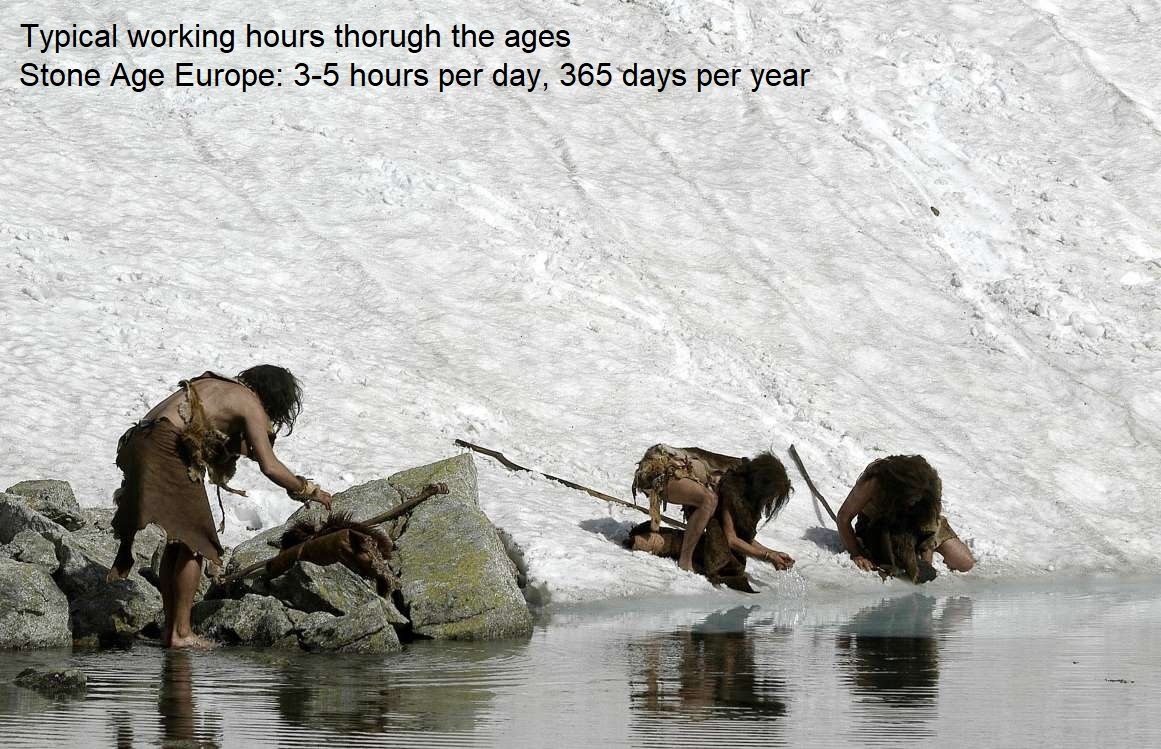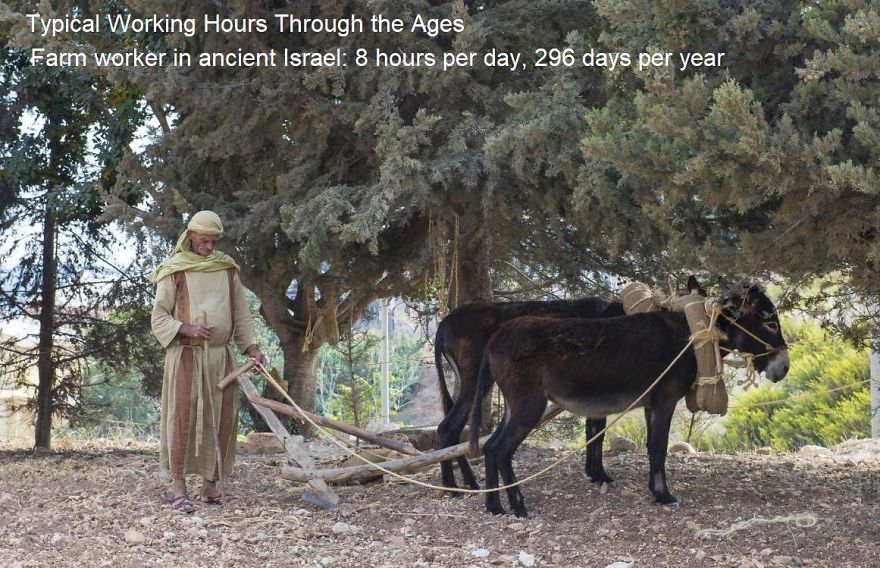(Story originally published on MSN)
Did you think you put in fewer hours than a Stone Age hunter-gatherer or medieval peasant? You might imagine workers in the 21st century have it the easiest (and in many ways we do), but when it comes to actual working hours, it may be a bit of a surprise. Looking back through time, this collection reveals how work-life balance compares today.
More info: msn.com
1. Stone Age Hunter Gatherer
Image credits: www.msn.com
By looking at modern hunter-gatherers, anthropologists and archaeology experts estimate prehistoric man probably worked just three to five hours per day, fluctuating wildly during the year. If food was plentiful, hunter-gatherers probably worked even fewer hours. They likely would also have taken time off to perform religious rituals, bury the dead, dabble in cave painting, and other non-work activities.
2. Laborer in Ancient Egypt
Image credits: www.msn.com
Examining records from Deir el-Medina, the village where (non-slave) artisans worked on the tombs in the Valley of the Kings, records show workers toiled for eight hours a day with an hour’s break for lunch at midday. Sounds pretty reasonable, and familiar. Keep in mind, though, the Egyptian week was 10 days long. The workweek lasted for eight days before getting two days off. However, it wasn’t all work. The records show laborers only worked for 18 out of every 50 days, taking time off for religious festivals and personal activities.
Farm Worker, Ancient Israel
Image credits: www.msn.com
The typical farm worker 100 BCE Israel tended crops approximately eight hours a day, with three of those hours set aside for prayer and eating. Work was strictly forbidden on the Sabbath, as well as during a number of religious observances. In addition, several workdays a year were likely to have been taken off for weddings and other personal events.
Artisan, Ancient Rome
Image credits: www.msn.com
Most free artisans (not slaves) worked six hours a day, from 6am to midday. Also, according to some historians, free Romans usually worked half the year due to the numerous festivals. The Romans used this abundant leisure time to visit local bathhouses, watch chariot races and gladiatorial competitions, attend theatrical performances and public executions, and many other activities.
Peasant, Medieval England
Image credits: www.msn.com
Life was far from easy for English peasants of the Middle Ages. According to Oxford don James E Thorold Rogers, the typical working day consisted of no more than eight hours. Farm workers put in longer hours at harvest time, but worked shorter days in winter when there were fewer hours of daylight. Sunday was the day of rest, but peasants also had plenty of time off to celebrate Christian festivals. Economist Juliet Schor estimates that in the period following the Plague they worked no more than 150 days a year.
Artisan in the 14th-century Aztec Empire
Image credits: www.msn.com
Workers in the Aztec Empire during the 14th century worked for four days on, one day off. On the day off, they went to the local market to stock up on provisions. They would also take time off to partake in religious festivals, many of which involved human sacrifice. The Aztec year comprised of 18 months that were 20 days long, at the beginning of each was a festival. Therefore, Aztec laborers would have stopped work 18 days of the year to participate in the monthly festivals.
Laborer in 17th-century France
Image credits: www.msn.com
During the reign of King Louis XIV, the workers of France had it tough, and hunger for the poorest in society was an unpleasant fact. The typical working day could last as long as 12 hours, with two hours set aside for lunch. Nevertheless, the record shows the Ancient Régime guaranteed peasants 52 Sundays, 90 rest days and 38 religious holidays off per year, meaning they worked just 185 out of 365 days.
Unskilled worker in mid-18th-century England
Image credits: www.msn.com
A 1998 study by historian Hans-Joachim Voth found workers in 1750 London worked 11 hours per day, five days per week. Sunday was the official day of rest, but workers also skipped on Mondays, at the time dubbed “Saint Monday.” Add this to the 53 holy days throughout the year, and the average Londoner worked around 208 days a year.
Factory worker in 19th-century England
Image credits: www.msn.com
The typical factory worker in mid-19th-century England toiled away for 16 hours a day, six days a week. At that time, the Industrial Revolution was in full swing and, due to a lack of regulation, factory owners could work their employees to the bone. The majority of holidays had been abandoned, with Sunday being the only day of rest. Workers could take off were Christmas Day and Good Friday unpaid.
Factory worker in 20th-century America
Image credits: www.msn.com
By the early 20th century, collective bargaining by unions and government regulation had resulted in the eight-hour workday becoming the norm in the Western world. In America in 1926, auto pioneer Henry Ford cut the workweek from six days to five. Many manufacturers followed suit, and the 40-hour workweek was adopted nationwide in 1940. Most workers took off the eight official public holidays, increasing to 10 days by the mid-1940s.
Hunter-gatherer in 20th-century Botswana
Image credits: www.msn.com
A 1960s anthropological study of the !Kung Bushmen of Dobe in Botswana revealed the adults of the tribe worked an average of six hours per day, two and a half days per week. In total, members of the tribe put in just 780 hours per year.
Hunter-gatherer in 20th-century Venezuela, Colombia, & Brazil
Image credits: www.msn.com
In 1987, a study of the Guahibo people concluded the adults spent just three hours a day hunting and gathering food, and occupying themselves with other work such as building shelters. Interestingly, the culture has no structured time sequences. There are 16 points in a typical year that are loosely marked, from the start of the dry and wet seasons, to specific days when certain fruit ripens or insects emerge, and these time periods vary. Assuming tribal members took time off on these special days, they probably worked around 1,047 hours a year.
Tech worker in 21st-century China
Image credits: www.msn.com
While the law in China limits the workweek to 44 hours, it is frequently ignored by employers, particularly in the technology sector. Offices typically employ the “996 work schedule,” where staff is expected to work from 9am to 9pm, six days per week. They get one hour in the middle of the day for lunch and one hour in the evening to eat dinner. Much of Sunday is no doubt spent in bed recovering from such an exhausting working week. Adding to the woes of tech workers in the country, paid leave is usually limited to just five days a year, though they are entitled to 11 paid public holidays.
Office worker in 21st-century Netherlands
Image credits: www.msn.com
Adults in the Netherlands have the shortest workweek in the world at just 29 hours, according to the OECD. This makes about 5.8 hours per day, which would be considered part-time in many countries. Still, the Netherlands has the second lowest number of public holidays in the world at just seven. Full-time employees are entitled to a minimum of 20 days off per year.
Office worker in 21st-century America
Image credits: www.msn.com
In America, the typical workweek, according to the US Bureau of Labor Statistics, is 34.5 hours, considerably longer than the average European workweek. That being said, many Americans slog away for much longer periods. In addition, unlike the paid leave legislation in Europe, American workers average a mere 12 personal days off per year and are allocated only 10 public holidays. Incredibly, US law doesn’t actually require employers to grant their staff paid leave of any kind.
2Kviews
Share on FacebookOne thing to note is that with a hunter-gather society, they are measuring ALL WORK. That includes work that has the same purpose as us going shopping, running errands, and doing chores outside of work. (So that would include making pottery and other cooking implements, making the houses, making clothes and weapons.) Normally anthropologists would also include child care in that, but not sure if that is included in the numbers here. So, the many years I spent working 60-90 hours a week did NOT include shopping, buying car tabs, paying bills, washing dishes and clothes, mowing the lawn, etc. No wonder half the world is sleep-deprived, stressed, and unhealthy.
One thing to note is that with a hunter-gather society, they are measuring ALL WORK. That includes work that has the same purpose as us going shopping, running errands, and doing chores outside of work. (So that would include making pottery and other cooking implements, making the houses, making clothes and weapons.) Normally anthropologists would also include child care in that, but not sure if that is included in the numbers here. So, the many years I spent working 60-90 hours a week did NOT include shopping, buying car tabs, paying bills, washing dishes and clothes, mowing the lawn, etc. No wonder half the world is sleep-deprived, stressed, and unhealthy.

 Dark Mode
Dark Mode 

 No fees, cancel anytime
No fees, cancel anytime 


































































17
4